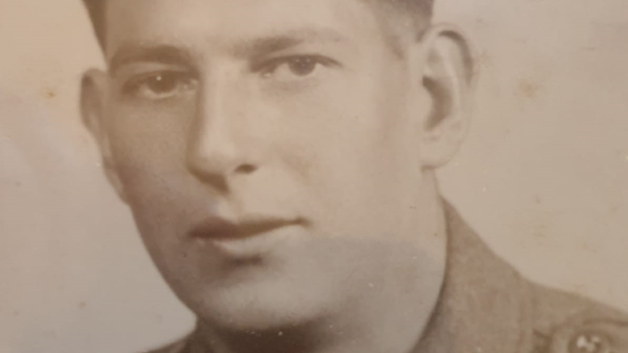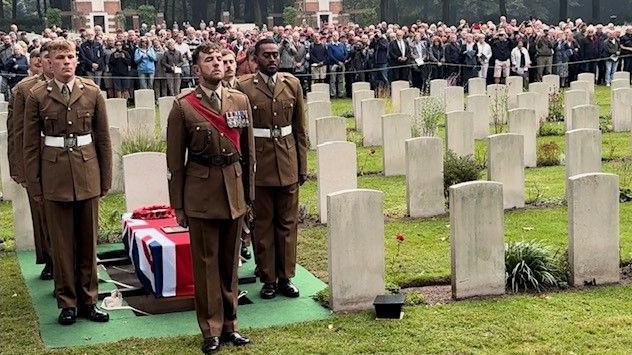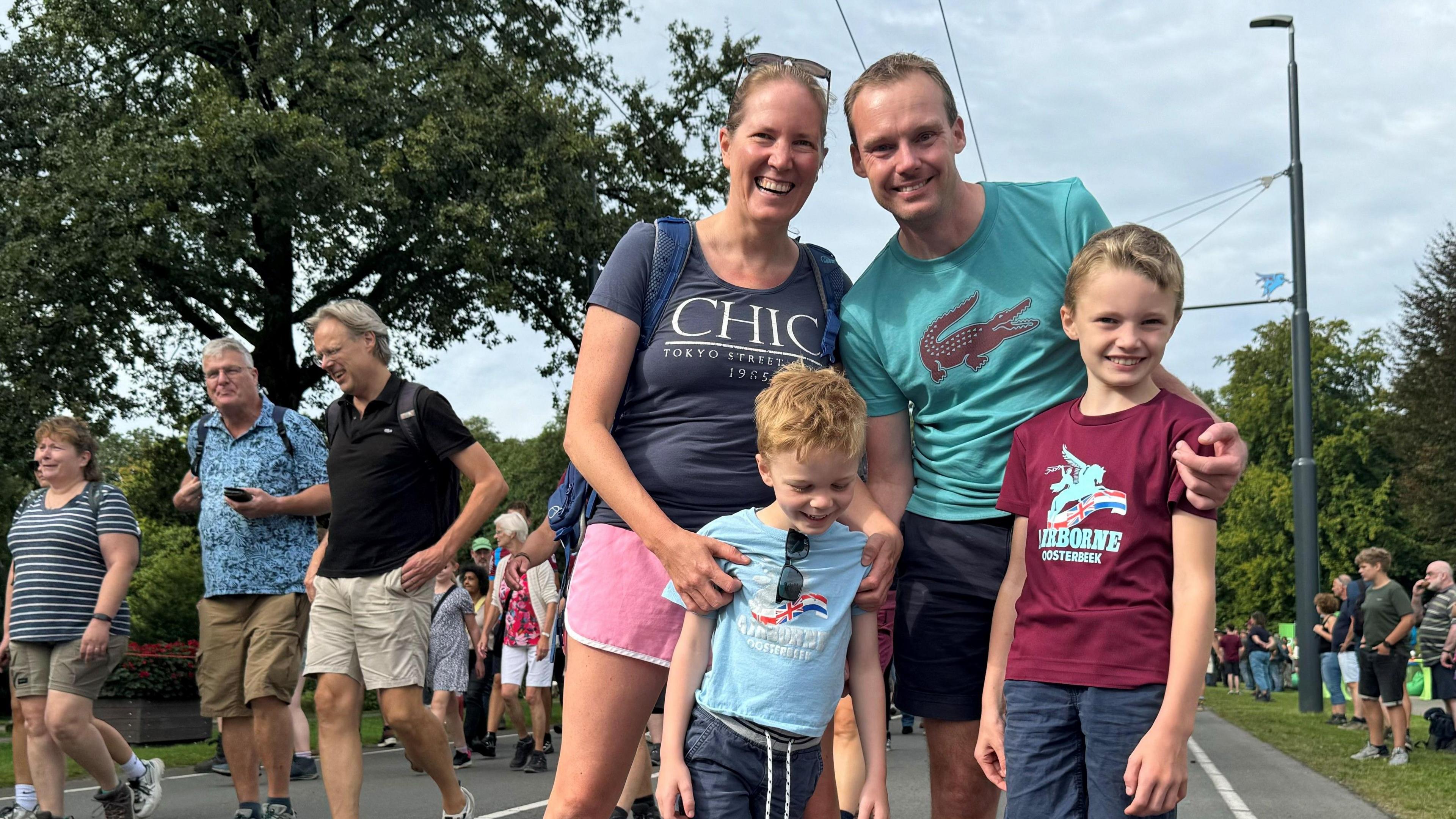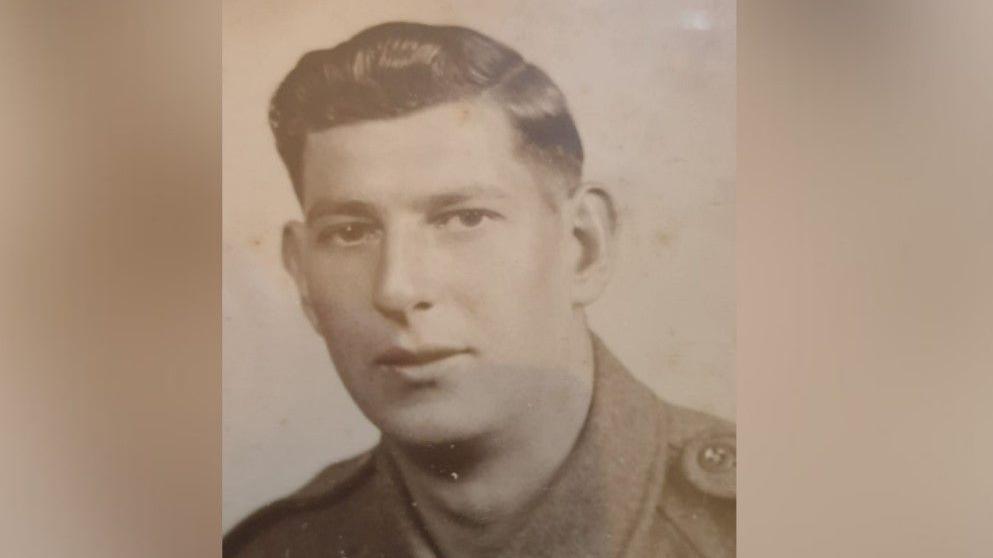Paratroopers mark 80 years since Operation Market Garden

Pte Henry Moon was among those killed in Operation Market Garden
- Published
Eighty years after hundreds of allied soldiers parachuted from military aircraft into Nazi-occupied Netherlands as part of a daring World War Two offensive, their modern equivalents will on Saturday repeat the jump in commemoration.
In an airborne spectacular, 700 paratroopers from eight Nato nations - including the Netherlands, Germany, UK and US - will parachute from 12 aircraft.
The jump will be done in two waves and those involved will land at the same location at Ginkel Heath, near the Dutch town of Ede.
Among them will be members of the parachute display team, the British Red Devils.
The airdrop is one of several events organised to mark the anniversary of Operation Market Garden, an ambitious military offensive designed to speed up the invasion of Nazi Germany and shorten the war in Europe.
Among those who parachuted into the Netherlands were 1,900 allied airborne soldiers from Britain's 4th Parachute Brigade.
It combined one of the largest airborne assaults in history, known as "Market", with a ground offensive, "Garden", aimed at swiftly capturing key bridges over the Rhine River.
Immortalised by the everyday phrase "a bridge too far", the failure to secure a final bridge at Arnhem was the result of stronger-than-anticipated German resistance, logistical setbacks and tactical decisions by Allied commanders.

Soldiers from the Royal Yorkshire Regiment carried Pte Moon's coffin to the war graves cemetery in Oosterbeek
Two British soldiers killed in Operation Market Garden were laid to rest earlier this week with full military honours in the Oosterbeek war graves cemetery, close to Ginkel Heath.
Their coffins were dressed in Union Flags and carried by military bearer parties.
Private Henry Moon, 7th Battalion, The Green Howards, was part of the ground offensive and was killed at the age of 21. His remains were identified through a DNA match.
It was a humbling moment, his great-nephew David Snowdon told the BBC, to see hundreds of people turn out to pay their respects.
Lieutenant Dermod Green Anderson, a glider pilot who landed with his troops in a village northwest of Arnhem, was killed when an enemy shell exploded near his trench just hours before the evacuation order came.
His great-nephew, Lieutenant Colonel Julian Anderson, watched as his wooden coffin was gently lowered into a freshly dug grave - stunned to discover his great-uncle’s body had lain undetected for decades nearby.

The body of Lt Dermod Green Anderson was also buried this week, having lain undetected nearby for decades
Many of the thatched roof villas and apartments around Arnhem display the merlot flag decorated with a leaping pegasus, dedicated to the British Airborne forces, to ensure the sacrifices made for their freedom are not forgotten.
Some of the most ferocious fighting took place on these tranquil, tree-lined streets during the eight-day battle.
The battles were so incongruously bloody that those who witnessed war on their doorsteps recalled taking refuge from the relentless gunfire and described the paratroopers dropping like "stars falling from the sky’"
The area was eventually swarmed by victorious Nazi soldiers and became one of the last places to be liberated from the Nazis.
This eastern Dutch region has long maintained its traditions as a heartland of Allied remembrance.

Sary and Mattijs van Gessel said the ‘Wandeltocht’ was a chance to educate their sons Koen and Tom
So, why do the Dutch still put such great emphasis on remembering the failed Allied effort?
Earlier this month, the BBC sought answers from walkers on ‘Wandeltocht’ - the world's largest one-day commemorative march that follows the footsteps of the Allied forces, passing key historical landmarks.
Thirty-four thousand people armed only with water bottles took part in the annual tribute, which encourages young and old to engage with history in a meaningful way.
As living memory passes with the remaining veterans, the Dutch feel a responsibility to share these stories and ensure their legacy is maintained.
Mattijs van Gessel’s sons Koen and Tom are hiding shyly behind his shorts. Their mother Sary told the BBC it was an opportunity to educate them.
"Wars take place everywhere and we tell them our safety is not something that you can take for granted," she said.
That morning, during breakfast, Sary said the family had discussed why all the military personnel were in the village.
"If this wasn’t happening then we wouldn’t be talking about it."

Amanda Juanita Diemel thought learning from the past was especially important given the world today
One gentleman, Geert, told me he had goosebumps on the walk. His adopted grandfather was wounded by a piece of shrapnel and was tended to by two Dutch nurses. The shrapnel and his beret are on display in the Oosterbeek museum.
"We would like to take it back for the family but it is more important for the world to see the evidence. It’s most important for kids to know it was real," Geert said.
Another participant, Amanda Juanita Diemel, told the BBC that they were "walking with history".
"It makes it very concrete, very tangible," she said.
"It’s important to keep it alive, to learn from the past, especially with everything going on in the world today."
As weeks of commemorations to mark the 80th anniversary of Operation Market Garden draw to a close, these moments have caused people to pause and remember the price paid to restore peace in Europe.

Witness History - Operation Market Garden
Thousands of Allied troops parachuted into Nazi-occupied Holland in September 1944. It was the most ambitious Allied airborne offensive of World War Two. The BBC World Service hears from Hetty Bischoff van Heemskerck, a young Dutch woman from the city of Arnhem, who watched the Allied paratroopers come down.
Related topics
- Published18 September 2024

- Published21 September 2019

- Published7 September 2019
